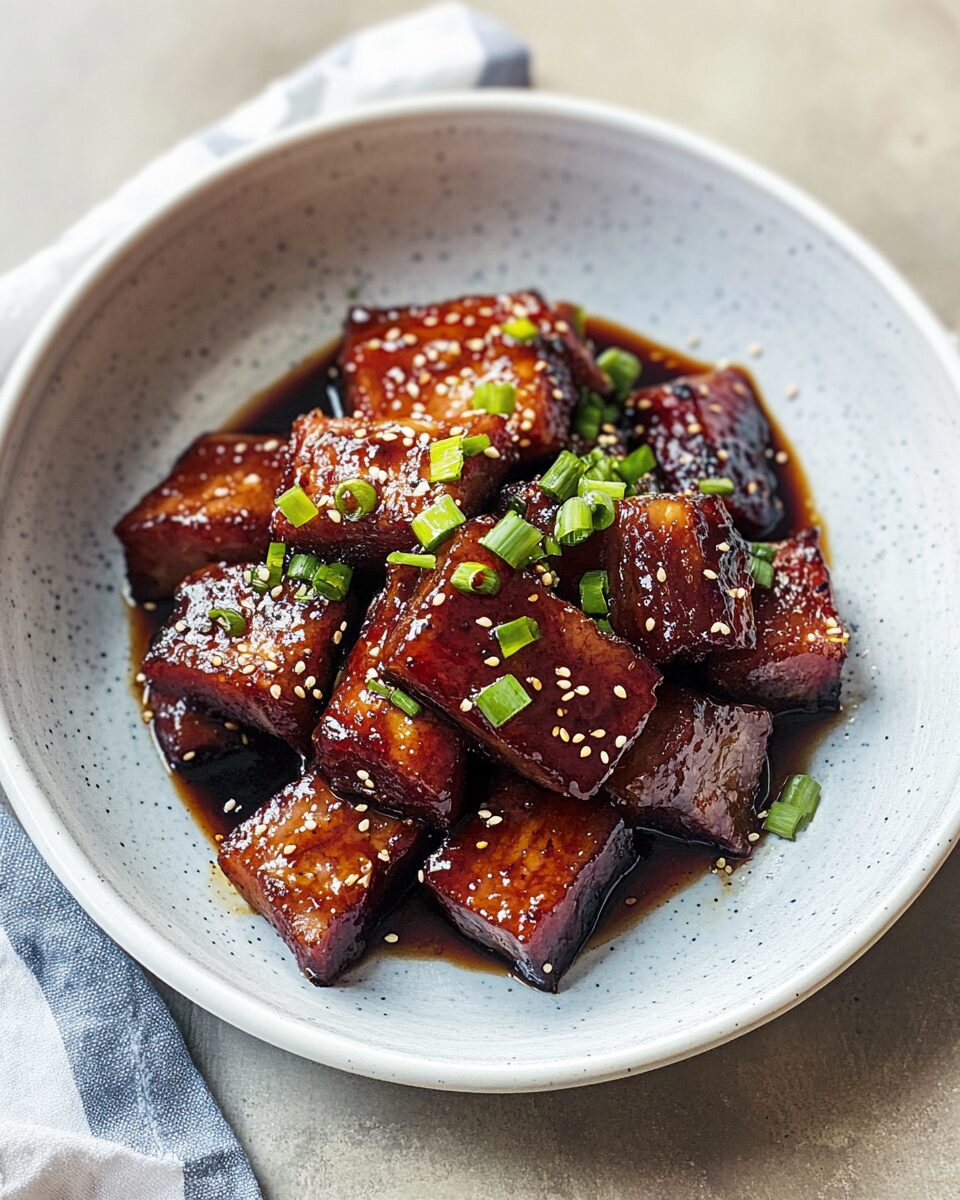This sticky slow-cooked pork belly recipe delivers a beautiful balance of tender, melt-in-your-mouth meat with a luscious, caramelized glaze that clings to every bite. The slow cooking breaks down the fat and connective tissue, resulting in an unctuous texture that is deeply satisfying.
The final high-heat roast crisps up the surface to create a shiny, sticky crust that contrasts wonderfully with the soft interior. Garnished with fresh green onions and toasted sesame seeds, it offers both visual appeal and a delightful hint of freshness. Perfect for sharing at dinner parties or elevating a simple weeknight meal.
Full recipe:
Ingredients:
-
2 lbs pork belly, skin scored
-
1/2 cup soy sauce
-
1/4 cup hoisin sauce
-
1/4 cup honey
-
1/4 cup brown sugar
-
4 cloves garlic, minced
-
1 inch fresh ginger, sliced
-
1/2 cup chicken broth or water
-
2 tablespoons rice wine vinegar
-
2 tablespoons sesame oil
-
1 tablespoon chili paste (optional)
-
2 green onions, chopped (for garnish)
-
Sesame seeds (for garnish)
-
Salt and pepper to taste
Directions:
-
Preheat the oven to 300°F (150°C).
-
Pat the pork belly dry and season lightly with salt and pepper.
-
In a large ovenproof pot or Dutch oven, combine soy sauce, hoisin sauce, honey, brown sugar, garlic, ginger, chicken broth, rice wine vinegar, sesame oil, and chili paste if using.
-
Add the pork belly, skin side up, and spoon some of the sauce over it.
-
Cover the pot tightly with a lid or foil and place in the oven. Slow cook for about 3 hours until the pork belly is tender.
-
Remove the lid and increase the oven temperature to 425°F (220°C). Spoon the sauce over the pork belly and roast uncovered for an additional 20-30 minutes until the skin is sticky, caramelized, and slightly crisp.
-
Let the pork belly rest for 10 minutes before slicing.
-
Garnish with chopped green onions and sesame seeds before serving.
Prep Time: 15 minutes | Cooking Time: 3 hours 30 minutes | Total Time: 3 hours 45 minutes
Kcal: Approximately 450 kcal per serving | Servings: 4 servings
The Science Behind Slow Cooking Pork Belly
One of the key secrets to achieving the perfect pork belly is slow cooking. Pork belly is a fatty, collagen-rich cut that requires low and slow heat to transform from tough and chewy into tender and succulent. Slow cooking gently breaks down the collagen into gelatin, which coats the meat fibers and keeps the pork moist and flavorful.
The long cooking process allows the flavors of the marinade and glaze to penetrate deeply into the meat, ensuring every bite is infused with the sweet and savory notes. Slow cooking also renders much of the fat, resulting in a silky texture without excess greasiness.
After slow cooking, increasing the oven temperature helps caramelize the sugars in the glaze. This Maillard reaction creates a crispy, sticky crust with deep, rich flavors and an attractive glossy finish. The contrast between the soft, tender pork and the crunchy, caramelized skin is what makes this dish so special.
Flavor Profile and Ingredient Synergy
The flavor profile of sticky slow-cooked pork belly is a perfect balance of sweet, salty, umami, and slight heat. The base of soy sauce provides saltiness and umami, while hoisin sauce adds a complex sweetness with hints of fermented flavor. Honey and brown sugar amplify the sweetness and help create that beautiful caramelized glaze.
Fresh garlic and ginger bring aromatic warmth and a bit of zing, balancing the richness of the pork. The optional addition of chili paste introduces a subtle heat that complements the sweetness, making the dish more layered and exciting.
Rice wine vinegar adds a mild acidity that cuts through the fat, providing a bright counterpoint and preventing the dish from feeling too heavy. Sesame oil contributes a nutty aroma that rounds out the flavors and adds depth.
This combination of ingredients mirrors classic Asian braising flavors but also appeals broadly due to its balance of sweetness and savory elements.
Tips for Selecting and Preparing Pork Belly
For the best results, choose a piece of pork belly that has an even distribution of fat and meat. The fat is essential to keeping the meat moist during slow cooking, while the lean parts provide substance and texture.
Scoring the skin before cooking is crucial. This technique allows the glaze to penetrate the surface and helps the skin crisp up during the final roast. Use a sharp knife to make shallow cuts in a crisscross pattern without cutting all the way through the meat.
Patting the pork belly dry before seasoning helps the glaze stick better and improves the texture of the final dish. Light seasoning with salt and pepper enhances the natural pork flavor without overpowering the marinade.
Serving Suggestions and Pairings
Sticky slow-cooked pork belly is versatile and pairs well with many sides. For a traditional approach, serve it with steamed jasmine rice or sticky rice, which soaks up the delicious glaze.
Light, fresh vegetables such as steamed bok choy, sautéed greens, or a crisp Asian slaw provide a nice contrast to the richness of the pork. Pickled vegetables like kimchi or pickled cucumbers add acidity that balances the sweetness and fat.
For a heartier meal, serve alongside roasted or mashed potatoes, or even noodles tossed in a light soy or sesame dressing. Garnish the dish with chopped green onions and toasted sesame seeds to add texture and a pop of color.
Variations and Customizations
One of the great things about this recipe is its flexibility. You can easily adjust the flavor by tweaking the glaze ingredients. For example, substituting maple syrup for honey adds a deeper, woodsy sweetness, while adding five-spice powder introduces warm, aromatic notes.
If you prefer a spicier version, increase the chili paste or add fresh sliced chilies. For a milder version, omit the chili entirely.
You can also adapt the cooking method for convenience. While the slow oven braise is ideal for tenderness, you can use a slow cooker or pressure cooker to speed up the process without losing flavor.
To make the dish more festive, add whole star anise or cinnamon sticks to the braising liquid for extra aroma and warmth.
Health Considerations
Pork belly is known for its richness and high fat content, so it’s a dish best enjoyed in moderation. However, the slow cooking process helps render much of the fat, and balancing the meal with plenty of vegetables can make it more wholesome.
Using natural sweeteners like honey and brown sugar instead of refined sugars adds a better quality sweetness. Additionally, homemade sauces allow control over sodium levels compared to store-bought glazes.
For those watching calories, smaller portions of pork belly paired with fiber-rich sides like greens or salads will create a more balanced meal without sacrificing taste.
Cultural Significance and Popularity
Sticky pork belly dishes have deep roots in East and Southeast Asian cuisines. In Chinese cuisine, braised pork belly dishes like Hong Shao Rou are celebrated for their rich flavors and comforting textures, often served during festivals or family gatherings.
This type of dish has also gained popularity worldwide due to its incredible flavor and the rise of Asian-inspired cooking trends. It embodies the culinary art of transforming simple ingredients into something extraordinary through technique and patience.
Food lovers appreciate pork belly’s ability to deliver luxurious mouthfeel and taste while offering a canvas for bold flavors. The sticky glaze adds an eye-catching shine and intense flavor, making it a crowd-pleaser.
Storing and Reheating Leftovers
Sticky slow-cooked pork belly keeps well in the refrigerator for up to 3 days when stored in an airtight container. The flavors often deepen overnight, making leftovers just as enjoyable, if not more.
To reheat, warm the pork gently in a pan over low heat to preserve its tenderness and avoid drying it out. You can also reheat in the oven at a low temperature, covered loosely with foil.
If the skin loses its crispness, a quick broil for a few minutes can restore some of the caramelized texture. Leftover pork belly can also be shredded and used as a filling for bao buns, tacos, or served over noodles.
Conclusion
Sticky slow-cooked pork belly is a dish that embodies comfort, depth, and celebration of flavors. The slow cooking process ensures tender, flavorful meat, while the sticky, caramelized glaze adds a delightful texture and sweet-savory complexity. This dish is perfect for those who appreciate slow-cooked meals that reward patience with rich and satisfying results.
Whether you are serving it for a special occasion or a cozy family dinner, this recipe is sure to impress. Its versatility in flavor and presentation allows for many creative adaptations, making it a timeless favorite in any kitchen.
With its roots in traditional Asian cooking and its wide appeal across different cuisines, sticky slow-cooked pork belly is a dish that brings people together around the table, sharing delicious moments and culinary joy.






